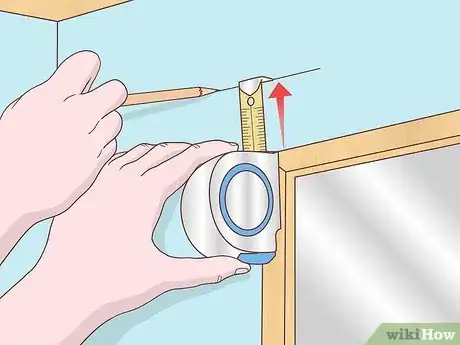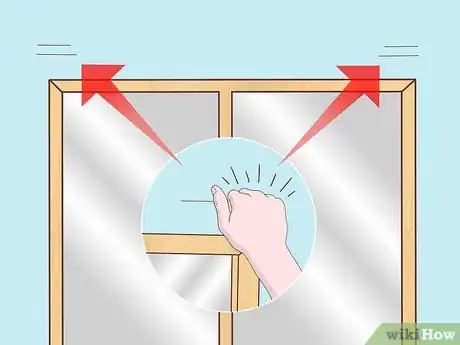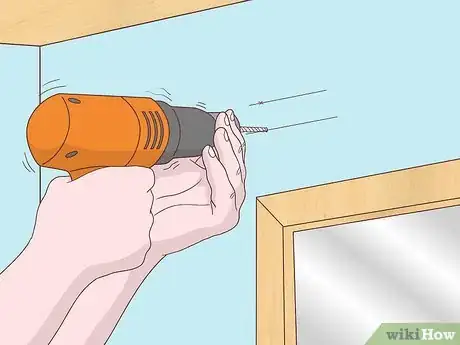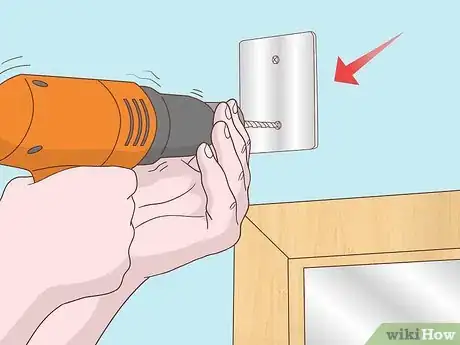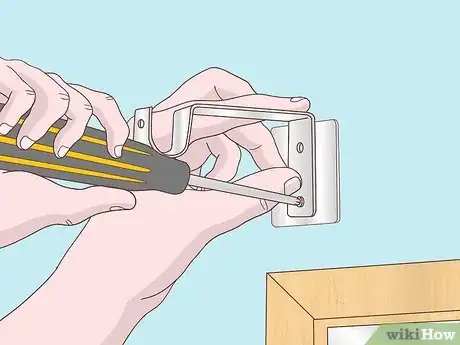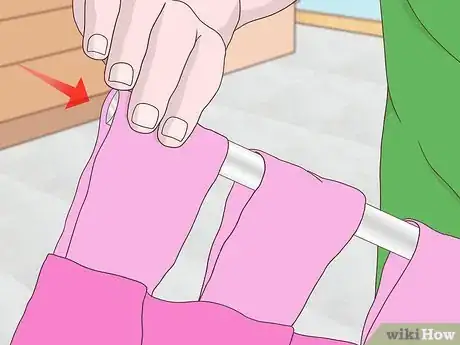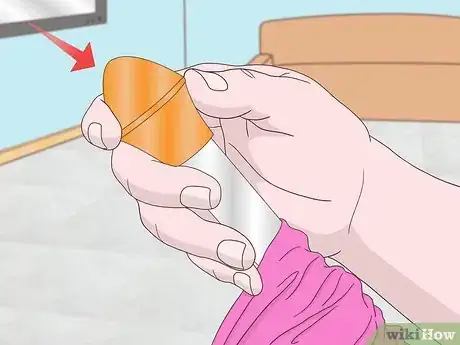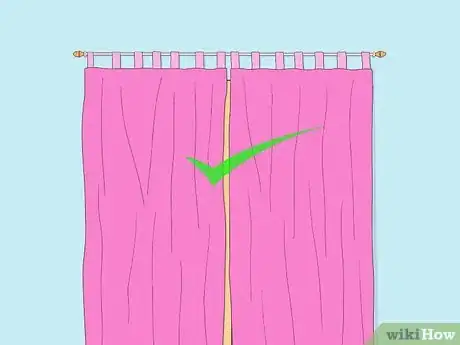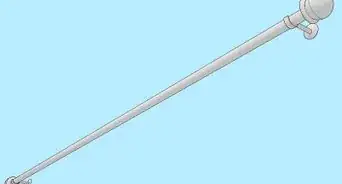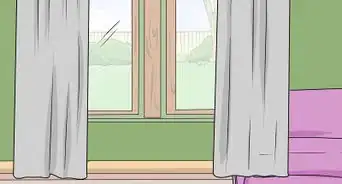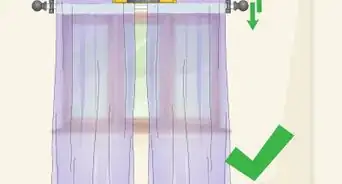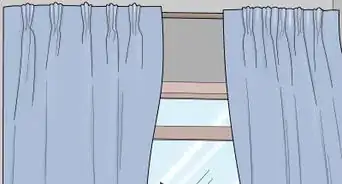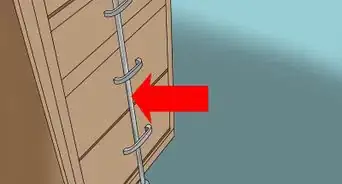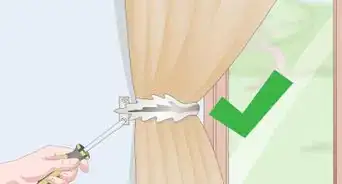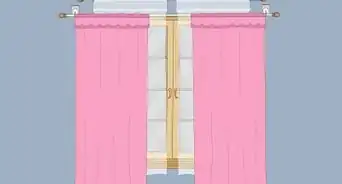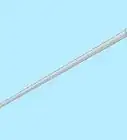This article was co-authored by Katherine Tlapa. Katherine Tlapa is an interior designer, currently working as a Design Specialist for Modsy, a design service based in San Francisco. She also runs her own DIY Home Design blog, My Eclectic Grace. She received her BFA in Interior Architecture from Ohio University in 2016.
This article has been viewed 35,257 times.
Curtains block sunlight, provide privacy and soften the somewhat abrupt edges of an undressed window. Hang your curtain panels from a rod system, which will allow you to easily pull the panels open or closed, depending on your brightness and privacy needs.
Steps
Planning Your Installation
-
1Determine how high to hang your curtains. Compare the measurements of your curtains and curtain rods to the window itself. Most curtain rods can adjust size to fit a variety of windows. Measure the length of the curtains to determine how high you want to hang them. Hang the curtains with your hands to the window to see the best location. It will help to have a pal test the location of the curtains for you.
- Avoid framing the window too tightly, which can make it seem smaller. To make the window seem larger, hang the curtains high above it.[1]
- Some prefer curtains to cover the window's entirety, while others prefer the curtains to cover the top half of the window.
Expert AnswerQA wikiHow reader asked: "How can I hang curtains without drilling into the wall?"
Katherine Tlapa is an interior designer, currently working as a Design Specialist for Modsy, a design service based in San Francisco. She also runs her own DIY Home Design blog, My Eclectic Grace. She received her BFA in Interior Architecture from Ohio University in 2016.Interior Designer
 EXPERT ADVICEAnswer from Katherine Tlapa:
EXPERT ADVICEAnswer from Katherine Tlapa:Katherine Tlapa, an interior designer, answers: "You can hang curtains on Command hooks. Any peel and stick hook will work - just attach them to the wall at one end of the window, the middle, and the other end (where your curtain rod would typically hang). Make sure you hang them so the rod stays level and that they can support the weight of the rod and curtain."
-
2Take measurements on the wall. Measure 2–4 inches (5.1–10.2 cm) above your window or window molding, depending on how high you want to install your curtains. Use a straightedge to draw a horizontal pencil line at this height. Draw the line slightly higher if you want your window to appear a little taller than it actually is.[2]
- Use a step ladder and a yardstick to create an accurate line.
- Ask a friend to hold the curtain rod above the window, then step back and see what they look like. Make any necessary adjustments before marking the line.
Advertisement -
3Map out where the curtain rod will hang. Extend the line about 2–4 inches (5.1–10.2 cm) past the window or window molding edges, depending on how far past the window you want your curtains to extend. If you want your curtains to make your window look a wider, draw the line a little further out than 4 inches (10 cm). Make sure your line extensions are equal on each side of the window.
- The extended lines will mark, roughly, where the ends of the curtain rods will be. Take into account the finials on the ends of the rod, if you plan to use them.
- Check the evenness of your line with a level. If the line isn't perfectly even, erase it and redraw.
- It’s best to plan for to hang the curtains higher, as opposed to installing low-hanging curtains.[3]
-
4Mark the placement of the rod for additional windows. If you are planning to mount several curtains, you should follow this same process on each window. Your room will benefit from even curtains around the room. Copy the measurements from the initial window to all the other windows.[4]
Installing Rod Brackets
-
1Test the walls. Knock on the ends of each line you drew. If the wall sounds solid, you're still on the wood that frames the window, and you can install the rods with screws only. If the wall sounds hollow, you should first install anchors.
- You could also use a stud finder to determine if the walls are strong enough to install the rod without anchors. Stud finders can be found at any hardware store.
-
2Punch a starter hole. Once you are satisfied with the line's placement on the wall, you should mark it. At the end of each line use an awl to punch a starter hole. Awls are common woodworking tools used to mark the beginning of a hole. Don't make the hole too large. It is best to make a smaller hole to help you align the screws later in the process.
- If you can’t or don’t want to drill holes in your wall, use adhesive hooks to secure the rod to the wall. Choose hooks that are strong enough to support the rod and curtains. Simply put the hooks where you would put the holes on either side of the window and set the rod in the hooks.
-
3Install an anchor. To ensure a secure hold of the curtains use traditional toggle bolts.[5] Screw the metal wall anchor into each hole, if necessary, with a power drill and a phillips head drill bit. It should be an easy installation and only require you to fully thread the anchor into the wall. Skip this step if you're installing directly into the wood.
- If your wall sounded hollow and you don't use an anchor, you could damage your walls. Your curtains could fall out of the wall and potentially injure someone.
-
4Mount the brackets. Hold a bracket against one of holes you punched. If you installed screw anchors, hold the bracket over one of the anchors you installed. Your brackets probably have two screw holes. Place the bracket's top screw hole over the hole or anchor.
- Hold up the bracket. Tape the bracket firmly against the wall with a couple of strips of masking tape. Repeat the process for the other bracket. This will help you attach the brackets to your walls. You can skip this step if you have a friend to help you hold the brackets.[6]
-
5Attach the rod brackets. Screw the brackets to the wall with their attached hardware. Remove the tape once the rods are firmly attached to the wall. Many find that it is beneficial to attach the curtains to the rod before mounting them to the brackets.
- It might be easiest to test the hold of the brackets before thinking about the curtains. Test the hold of the brackets by mounting the rod into the bracket's slot.
Hanging Your Curtains
-
1Thread the rod through the curtains. Attach your curtains to the rod before hanging the rod from its brackets. This will make things easier for you. Clip the straight tops of tab-less and pocket-less curtains with curtain clips. Start at the outer edge of each panel and space each clip evenly.
- Thread the rod through the top pocket opening of the rod pocket curtain panels. Pull each tab loop of both curtains over the rod.
- For curtains with grommets, pull the rod through the grommets. Either keep the grommets facing the same way or create a weaving pattern.
-
2Secure the rod to the brackets. For most bracket and rods systems, you'll either thread each end of the rod through the bracket holes or place the rod on top of a crescent-shaped depression in the brackets.[7]
-
3Finalize the installation. Press the 2 finials into each end of the rod, or screw them in place, depending on their construction. Once the curtains are hanging from the rods in the desired spot, test the curtains. Make sure you can move the curtains as they’re designed to move.
- If you plan to use tiebacks, mark where they will go at this point. Or, use a cord or ribbon to tie the curtains back.
Expert Q&A
-
QuestionWhich side of the curtain should face outside?
 Katherine TlapaKatherine Tlapa is an interior designer, currently working as a Design Specialist for Modsy, a design service based in San Francisco. She also runs her own DIY Home Design blog, My Eclectic Grace. She received her BFA in Interior Architecture from Ohio University in 2016.
Katherine TlapaKatherine Tlapa is an interior designer, currently working as a Design Specialist for Modsy, a design service based in San Francisco. She also runs her own DIY Home Design blog, My Eclectic Grace. She received her BFA in Interior Architecture from Ohio University in 2016.
Interior Designer Most of the time, you want the patterned side of the curtain to face inside towards the interior room. If you want the outside to see the curtains as well, you can buy two panels and stitch them together back-to-back for a streamlined look.
Most of the time, you want the patterned side of the curtain to face inside towards the interior room. If you want the outside to see the curtains as well, you can buy two panels and stitch them together back-to-back for a streamlined look. -
QuestionDo the curtains need to touch the floor?
 Katherine TlapaKatherine Tlapa is an interior designer, currently working as a Design Specialist for Modsy, a design service based in San Francisco. She also runs her own DIY Home Design blog, My Eclectic Grace. She received her BFA in Interior Architecture from Ohio University in 2016.
Katherine TlapaKatherine Tlapa is an interior designer, currently working as a Design Specialist for Modsy, a design service based in San Francisco. She also runs her own DIY Home Design blog, My Eclectic Grace. She received her BFA in Interior Architecture from Ohio University in 2016.
Interior Designer Curtains do not need to touch the floor. There are different types of curtains for different styles, and if you want your curtains to puddle on the floor they can, or they can hit just a few inches above the floor.
Curtains do not need to touch the floor. There are different types of curtains for different styles, and if you want your curtains to puddle on the floor they can, or they can hit just a few inches above the floor. -
QuestionDoes the sheer mount slightly below the top of the curtain or do the tops even out?
 Katherine TlapaKatherine Tlapa is an interior designer, currently working as a Design Specialist for Modsy, a design service based in San Francisco. She also runs her own DIY Home Design blog, My Eclectic Grace. She received her BFA in Interior Architecture from Ohio University in 2016.
Katherine TlapaKatherine Tlapa is an interior designer, currently working as a Design Specialist for Modsy, a design service based in San Francisco. She also runs her own DIY Home Design blog, My Eclectic Grace. She received her BFA in Interior Architecture from Ohio University in 2016.
Interior Designer The sheer mounts below the top of the curtain, just slightly. You only want enough space so that it can slide easily back and forth, but you don’t want to see a big gap between the two.
The sheer mounts below the top of the curtain, just slightly. You only want enough space so that it can slide easily back and forth, but you don’t want to see a big gap between the two.
Things You'll Need
- Measuring tape
- Pencil
- Level
- Awl and hammer
- Power drill with phillips-head bit
- Bracket, rod and finial system with included hardware
- Masking tape
- 2 curtain panels
- 2 metal screw anchors (optional)
- Curtain clips (optional)
References
- ↑ https://www.realsimple.com/home-organizing/decorating/curtains-window-treatments
- ↑ http://www.housebeautiful.com/home-remodeling/interior-designers/tips/a2819/hanging-curtains-mistakes/
- ↑ http://www.apartmenttherapy.com/how-to-hang-curtains-227318
- ↑ http://www.housebeautiful.com/home-remodeling/interior-designers/tips/a2819/hanging-curtains-mistakes/
- ↑ http://www.naturalhandyman.com/iip/inffastener/infanchor/infanchor.html
- ↑ https://books.google.com/books?id=MZahL4tyzOQC&pg=PA325&dq=how+to+install+curtains&hl=en&ei=8BWjTbhwiOLRAeGdgd8I&sa=X&oi=book_result&ct=result#v=onepage&q=how%20to%20install%20curtains&f=true
- ↑ http://www.apartmenttherapy.com/how-to-hang-curtains-227318

